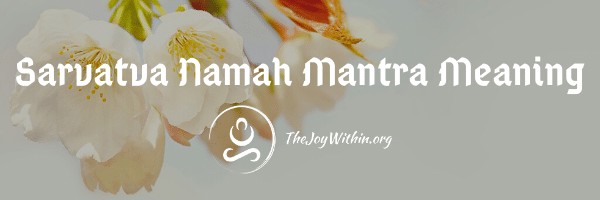Sarvatva Namah is a sacred and powerful Sanskrit mantra. Sanskrit has been mainly used as a philosophical language within the religions of Buddhism, Hinduism, and Jainism. It is known as the mother of all languages and is one of the oldest languages in the world.
Mantra Meaning
- Sarva – meaning wholeness, it includes all the interwoven layers of the universe
- Namah – meaning I open my individuality to the true essence
Put together this mantra works to welcome the divine to work through your individuality. It reconnects you to your true essence and eternal nature.
It opens up your body, mind, and spirit to the true essence of the universe. It works to reignite your inner channel to the infinite cosmos.
When using this mantra you are practicing the law of pure potentiality as stated within Deepak Chopras 21 day meditation challenge, where he guides you through a meditation lesson each day.
The law of pure potentiality states that our natural way of being is in the realm of pure awareness and within here is unlimited potential.
This reminds us that we are the creators of our world. Along with when we slow down we can begin to notice the subtle layers of our beingness.

How To Use Mantras
A mantra is a sacred intention you repeat in a meditative space in order to align with its message. To begin, find a comfortable and quiet space where you can be undisturbed.
You can set the mood by lighting candles, finding a nice space outside, or cleaning the area you plan to meditate in. The environment you meditate in can have a direct impact on your ability to focus.
• Bring your awareness to your breath and take note of the state it is in without trying to change it
• Scan your body with your mind’s eye and focus on where your body makes contact with the earth
• Spend at least five minutes arriving into a more calm and centered mental space before beginning chanting
• You can use mala beads to assist you in chanting, chant in your head upon each exhale, or verbally chant aloud
• Repeat the chant for at least ten minutes to reap all the benefits of the meditation
• You can set a timer so that you know when to bring your focus back and so that you do not lose your mental focus wondering how long it has been
• Bring your focus back to your breathe and take notice of the state of your mental body once it has returned to silence
• Feel your body connecting with the ground once again and when you are ready, open your eyes
If your mind wanders off during meditation try these tips to gently bring it back. It is called a meditation practice because it is not meant to be perfect and every day you will be in a different mental state.
Continue to practice anyway and with a non-judgemental attitude. Allow yourself to take note of how your practice affects you and how you feel afterward.
Incorporate This Mantra
You can incorporate this mantra into your yoga practice by chanting it upon the exhale. When using this mantra in your pranayama you can chant it aloud or slightly within your head on each exhale. The effects may be different when chanted aloud or silently.
To maximize its effect on the asana practice you can chant this aloud on each exhale in a repetitive dynamic sequence such as standing mountain pose folding into Uttanasana.
Focus on extending your breath while keeping your inhale and exhale the same length. Repeat this movement at least five times, then arrive in Uttanasana in order to take notice of its effect on your body, mind, and spirit.
Further Reading
You can learn and work with other mantras such as:




